On the Druid’s Garden homestead, we have many feathered friends. I think a lot of people see birds just as livestock, but here, we see them a little differently. Thus, I wanted to create a short guide for people who were thinking about cultivating a relationship with a backyard flock of birds but they weren’t sure what kind of birds they might want! Of course, this is my own druid perspective on homestead bird flocks, which might be a bit different than what you’ll find on more general sites. In this guide, I’ll talk about a variety of backyard flock breeds, how they might help your garden and homestead, challenges, temperament, and more. I will also note that I haven’t raised birds for meat, so I won’t talk about that much in this guide. I’ll cover four common backyard flock birds: chickens, ducks, geese, and guinea fowl.
Entering Into Relationship
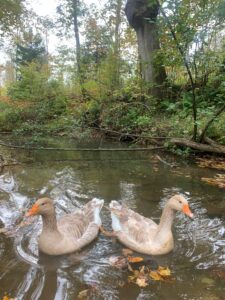
Stemming in part from my post last week where I talked about seeing all aspects of nature as sacred, having agency, and the need to honor life, I think it’s important to start any conversation about backyard flocks from this perspective.
Before entering into any relationship, it’s important to start with your own intentions and think about these questions framed by relationship. What do you want from backyard birds? What can you offer them? For us, we keep our birds as pets, as companions, and as helpers on the homestead. Our intentions are to let them have long, happy lives and to build relationships with them. And we work to offer them plenty of free-ranging outside time, secure and safe coops and runs, healthy food, treats, and a variety of things to keep them entertained. Like any other relationship: the more I invest, the more rich rewards I gain. Many of the backyard bird breeds, when offered good housing, shelter, food, and so on, can live many years and provide you with amazing companionship and joy.
This relationship and intention might be different if you are raising birds for pets vs. meat. For meat animals, I ascribe to the “one bad day” philosophy. When raising meat birds, those birds should have the best life possible up until their “one bad day.” Animals can have great lives even if they are intended to be eaten. Raising meat birds personally isn’t something I do but I support others who do so ethically.
Thus, these birds are living, breathing autonomous individuals with their own desires and capacity for love/friendship. Each one has their own personality and is unique. The more you treat them as deserving of this respect, the more rewards you will have from raising them. And certainly, this kind of thinking I’m advocating here goes against much of the conventional wisdom about “barnyard animals” and their treatment.
Flock Overview:
Now that we are through the philosophy of raising backyard birds, here are some of the backyard flocks that you can consider raising. We are currently raising all four of these flocks and have hand-raised all from babies or eggs.
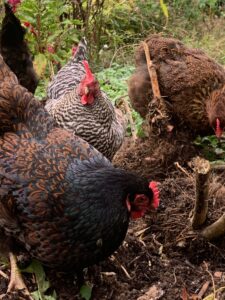
Chickens: Most people are most familiar with chickens of the birds on this list. I love chickens and have kept them for most of my life. They are fun, quirky, entertaining, and sweet-mannered. I only raise heritage breeds because these breeds are older and live longer (8-12 years). Some breeds of chickens today are genetically selected to grow quickly, have large breasts, or produce so many eggs that it soon destroys their poor bodies–these are battery hen breeds (and are only expected to live 1-3 years). I will rescue battery hens, but never seek them out as peeps! A good heritage breed chicken will lay anywhere between 200-300 eggs a year and live 8-12 years. They typically stop laying during the darkest and coldest months–some chicken owners will choose to put a light in their coop at night to encourage them to lay through the cold and dark parts of winter, but I prefer to let them have a break and work with nature. If the girls want a break from egg-laying at the winter solstice, they can have it!
Good heritage breeds are Wyandottes, Rhode Island Reds, Black Copper Marans, Easter Eggers, Plymouth Barred Rock, Australorps, and Cochins. If you are in an area with *any* hawk pressure, I would not recommend bantams or Silkies, but rather, full size hens. If you want a rooster for protection, consider standard size hens and a bantam rooster–a larger rooster can be rougher on the girls, pulling out feathers, etc. A bantam rooster can still protect but can’t be as rough. One rooster is all you need for up to 12 hens!
Chickens prefer to free-range and are omnivores. They also love food scraps and leftovers, and so, when I go out to eat, I always bring anyone’s unwanted leftovers back for them. They are so happy to have anything to peck and scratch at. They can eat almost anything except potato peels. They adore moldy cheese! So you can certainly have them help transition compost into soil and eggs!
The biggest problem with chickens can be their scratching behavior. If you have nice garden beds, new seedlings, nice landscaping, or anything covered mulch, you won’t soon because chickens dig it up. This digging action can be put to good use for fall beds and fall leaves but during certain parts of the year, keeping chickens out of beds and gardens is necessary. I like to send the chickens into the garden in the fall, where they can dig up all the grubs and worms and help till the soil for next season and deposit their rich fertilizer!
Personality-wise, chickens are more independent than the rest of the birds on this list. The flock may scatter often, with each individual chicken going off on her own to peck and scratch at what suits her fancy or small groups of hens may wander here and here. Thus, you will see them dotted everywhere when they are free-ranging. This means it’s easier to lose a single chicken because they don’t stick together. We have one currently have one rooster and eight hens, and he can’t stay with all the hens when they scatter, which is a bit of a problem when he’s watching for hawks. But Pythagoras does his best!
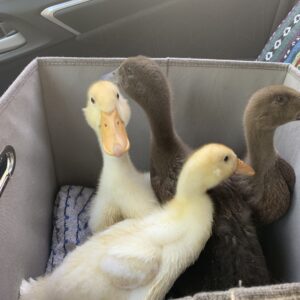
Ducks are considered one of the best flocks for all-purpose backyard homesteads. This is because they don’t scratch up your mulch, are excellent at garden grubbing, and they can lay as many eggs or even more eggs than a chicken. Ducks do need access to more water than chickens; ours get a kiddie pool filled with freshwater (usually twice daily in the warm months) and they are quite content. The area around their kiddie pool will eventually turn into an absolute mud pit, so do be aware. Wherever there is water, there is a muddy duck, however, so if you have water features on your landscape, this is something to keep in mind. In the winter, they get a smaller bucket that they can dip their beaks and heads into that sits on a heated waterer.
Ducks are great for gardens and the smaller breeds (like Khaki Campbells) are light enough to not damage garden plants. On the other hand, our Pekins just stomp small plants down with their heavy bodies, haha! There are many possible heritage breeds for ducks, but you want something less heavy if you are going to be having them eat slugs in your garden.
Ducks are very social with each other and form a tight-knit community. I have never seen any of our four ducks stray more than about 10 feet from the other ducks. When they move, they move as a unit, like a quacking, waddling school of fish. They have a great deal to say and constantly will run commentary on anything you are doing (or anyone else is doing).
Geese are my favorite of the backyard flock birds. When I was a kid, I was chased by a flock of mean geese and cornered on my uncle’s porch for almost an hour till my father rescued me. Thus, I never considered them an option for a backyard flock, but my partner talked me into it and I’m so glad he did. Some breeds of geese are the most friendly and intelligent of all of the birds listed here. The breed that we raise right now is called American Buff, and they are beautiful, super friendly and curious. One gander can mate (for life) with several geese. On our homestead, we have a mated pair and they are always together–and usually following one of us around as we work on the homestead.
Geese lay about 20-50 eggs a year (depending on the breed), but each egg is enough for a meal for two people (and if you do pysanky, goose eggs are amazing). They are vegetarians, eating grass as their primary food source. Our geese are on the lawn all day, grazing it and chirping in joy. Like ducks, Geese need access to pools of freshwater–our geese have a large tub that we fill up daily for them. We also give them the smaller tub in the winter for their heated waterer when necessary. They aren’t filthy like ducks though and don’t make a mess of their water.

Both geese and guineas (below) are excellent “guard birds” in that they sound a loud alert when someone comes up or driveway or they see a predator. The geese will also aggressively chase something off if they can. This can be useful for the homestead as a whole, and also keep you apprised of the overall situation (especially if you don’t have a dog for these purposes). Geese are quite loud, especially when they get their adult voices, so this is something to keep in mind. When my geese want something (like grapes or chestnuts) they will honk quite loudly.
Geese will go in the garden, and while you can get them to weed grass for you, they will also likely take a big bite out of some of your ripe fruits and veggies, so keep that in mind. Also, coming in at 18-20 lbs a bird, they are heavy and can crush seedlings and small plants.
Geese are also by far the most intelligent, curious, and personable of the birds listed here. They enjoy playing with cat and dog toys, chewing on anything they can (including your hair, clothing, etc) and getting themselves into trouble. I love them so much and if you are looking for a companion bird, I would suggest a pair of geese. Some people do bring their geese in the house and train them with diapers! I wish I had thought of that when mine were young!
Guineas / Guinea Fowl are the least domesticated of the flocks present here, in that they won’t want cuddles or to be pet, but they are still very friendly and fun. They are loud, with a range of different calls and honks, which help scare away predators and alert you as to what is going on. I think they are by far the most aware of their surroundings and hence, you can learn a lot about nature observation from watching them. Like the ducks, they move like a school of fish and stay close to each other. Particularly in their first year of life, they are pretty jumpy, and you’ll often hear them doing their loud alarm calls. They also have other lower whistles, which they use when they want you to do something (like offer them treats or mealworms). Guineas are powerful birds, and even though they are the smallest of the birds on this list (weighing only 3-5 lbs) they are able to fly and move very quickly. If a guinea doesn’t want to be caught, the guinea will not be caught! We have trained them with hand signals and mealworms–with a single hand signal, we can get them to move in a certain direction or go into their coop (our independent-minded chickens would never do such a thing).
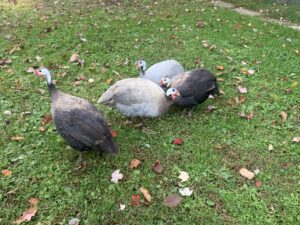
Guineas are fantastic tick control. With the rise of tick-borne illnesses and radically increasing tick populations, we got the guineas to help us address a growing tick population. Since getting the guineas, the ticks have been far less and our lives have been more joyful because the guineas are such fun. The guineas are excellent in the garden for bug control of all kinds–bugs have no chance with an army of chickens and guineas let loose!
One of the things about guineas is that they want to roost in trees at night. Thus, we always make sure we put our guineas away at least 45 min before dark or they will be 50 feet up in a tree and we won’t be able to get them down. Roosting like that keeps them away from some ground predators, like foxes or coyotes, but makes them easy to pick off by owls. A lot of people around here raise up a guinea flock and just let them go once they are about 10 weeks old–they rarely live a year (and often much less than that) with that approach. One friend raised up 10 and lost them all within 3 weeks. I don’t think it’s safe or ethical to raise and release in that way. Rather, we lock our guineas up with our chickens when we aren’t home and at night. The guineas have their own separate run during the day for when they are in the run, and they roost with the chickens at night. Thus, our guineas are two years old now and should live their full lifespan of 8-10 years with protection and night safety.
Raising Birds
Once you’ve committed to getting some birds you have to make is whether to get peeps or raise them yourself. Remember that all of these birds are flock animals and cannot be raised alone, so you will want to think about how many you want.
Hatching Eggs. We raised up two of our four ducks from eggs our friends had given us–the incubator with seven eggs sat on our counter for a month. One peep hatched successfully and my partner had to intervene and help the second hatch–they are now our large and beautiful Pekin Ducks (white) that you see in the photos here. I loved that experience because you got to be the only one the ducks had ever seen–they’ve been here since they were eggs. We sang to the eggs, cuddled the eggs, and welcomed them to our lives before they were even born. If you have a broody hen, you can also get her to hatch some eggs for you (she will hatch anything but a goose egg–it is too big for her to sit on!) The problem with hatching eggs is that it is what is known as “straight run.” You may get all males or all females or a mix of both. And the gender balance in your flocks can be the difference between a flock with fighting and a peaceful flock (as a rule of thumb, too many males equals trouble). We have that problem now–too many male guineas and ducks, which means either we cull the flocks (which we will not do) or get some more females in the spring (which is our plan).
Young Peeps/keets/goslings/ducklings: You can also get peeps locally (around here our feed store carries them in the spring) or through the mail. I’ve done all of these options and all seem to work fairly well. We had to get our geese via mail because we are raising an endangered heritage breed and nobody around here carries any geese, much less American buffs. They are overnighted within 24 hours of being hatched (they don’t need to eat or drink for the first 48 hours of life) and you call the post office and let them know about the birds coming in. They are usually tired from their journey for the first day and then perk up after that. I prefer to get local stock when I can, but it’s not always possible.

Flock cohesion: One of the things that we have found is that a flock that is raised together, stays together. If they aren’t raised together, they will form separate flocks, even when living in the same area. Sometimes they can become friends, but often, they will always be separate. Case in point, we raised our guineas about 5 weeks ahead of our chickens and started to integrate them as soon as we could. Even though they spent their adolescence and adult lives living and roosting in the same area, they are always two separate flocks and the guineas are a bit aggressive with the chickens (hence their separate run). We suspect that if we had raised them together, they would live together and get along a bit better. Same with our geese and ducks. The ducks were about 3 months older than the geese, and the ducks picked on the geese when they were little and they were out together. Now the geese are not taking anything from anyone, and they are a full 8-10 lbs heavier than even the ducks….but I wish sometimes they would get along better. In talking to other friends who have these flocks, if we raised the ducks and geese together, we would not have this problem.
Needs for flock raising:
All of our flocks required fairly similar setups for incubating and raising babies, but each has its own needs and nuances.
- Chickens are very easy to raise, but by comparison to geese and ducks, grow much more slowly (assuming heritage breeds). They take a while to get large enough to have their full feathers and be outside (about 12 weeks) A heat light, source of food and water, and clean bedding are essential. I also like to give the little ones lots to explore and peck at, so I give them fruits, veggies, scrambled eggs, etc. Chickens are very tame when they are little and the more you handle them, the better. They are so much fun to cuddle and hold when they are little.
- Guineas have very similar requirements to chickens, but they are wild and will want not to be handled. From the beginning, they will likely avoid you and freak out when you are near the brooder; that is part of their wild nature. As they get older, they can be worked with and you can develop a great relationship with them–but they are not birds to be cuddled. They also can fly out of the brooder really easily. Guineas don’t do well with change–once we moved them out of the brooder and into the coop, they stayed in the coop for about 4 weeks solid before being willing to come out. They eventually did!
- Ducks are the most difficult by far to raise because they are obsessed with water and poop a lot! They make a horrible mess of their brooder almost immediately. Finding some way of catching the water before it goes into the bedding is essential; if not, you will be cleaning the brooder literally 3-4 times a day. A setup like this one works well! Ducks are fun to handle and mild-mannered; you can put them in your bathtub or sink and let them swim. They don’t have their own oils till their feathers grow in though, so you have to limit swimming time to 10-15 min till they are older. They are really personable and friendly when they are little.
- Geese are super easy to raise–they don’t make the water mess that the ducks do and will bond with you quickly and follow you everywhere. They also enjoy swimming. They also have interesting tastes, and you can hook them on some veggies and fruits early in life (which will keep them coming back to you as they get older). Our geese basically followed us around for 3 months while they were growing up and wanted to do everything we were doing. It was a blast.
- All of these little ones need to be kept warm; ducks and geese need less warmth than guineas and chickens. Basically, the rule is to keep them at 95 degrees the first week, 90 degrees the second week, 85 the third week, and so on. Geese and ducks want their temperature dropped a little faster; I think its due to the thicker down they have.
I prefer to raise little ones later in the year (starting in early June) so that they can see the sun and get outside as soon as possible. That way, they can start to eat grass, see the land that will be their home and so on. If you raise them in the summer months, they can go outside early because it is warm. That’s important to me–that they see the sun.
Predator Protection

One of the things I tell my chickens every day is “Be careful girls. You are made of chicken! Everyone wants to eat you!” They ignore me, scatter across the property, and proceed to eat bugs. Predator protection is a serious issue and you must take it seriously from day one or you will lose birds quickly. During the day, it is often hawks or neighborhood dogs that cause the most problems. We have found that hawks get more desperate for food in the dark half of the year, and thus, we usually have to let the chickens out only with supervision during the months of November through March. Most of the birds have a good sense of self-preservation (except the chickens who seem oblivious to the fact that they are made of chicken) and the flocks are alerted at the first sign of an overhead hawk. Our geese are good hawk deterrents and we’ve seen a lot less hawk activity since they grew up and started honking.
At night it might be a fox, raccoon, weasel, or fox that is trying to eat your birds. For this, you want really carefully constructed coops that provide day and evening security (especially for when you aren’t home). For our ducks, guineas, and chickens, we have covered runs so hawks can’t fly in. The entire run is wired together and we also sunk the wire in an L pattern into the ground, several inches deep, to prevent raccoons or weasels from burrowing in. Within each of those secure runs is a secure coop that gets locked up tight each night with a raccoon-proof lock. Whatever you do, don’t purchase one of those cute-looking cedar chicken coops they sell at the big box stores and online. They are all much too small reasonably for birds and their security is non-existent (a raccoon can open any of the latches on those coops) and they are super flimsy (something could break it open easily). I can’t tell you how many people have lost birds who have started with one of those cheap coops. You are better off building something on your own if you can. Paying attention to your security will ensure many years of happy flocks.
I will also say that we have lost birds over the years. The last bird we lost was Chickweed, one of our Australorp hens, about this time last year. A hawk got her when she was on the other side of the house and away from our other flocks. Rather than driving the hawk off, we put the rest of the birds in the run and then let the hawk have her meal, recognizing that this was the cycle of life. We held space. After the hawk was done, we took her out into the woods and left her there with a chicken funeral. We recognize that, as druids, the cycle of life is part of our existence. While we do everything we can to be vigilant to minimize losses, we also realize that sometimes they are inevitable, and we honor all life–even the hawks.
Treats and Training
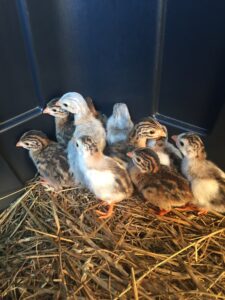
Treats can help you train your birds and bond them to you. All four of our flocks, even our vegetarian geese, love mealworms. You can grow them yourself or get them dried in bulk. The mealworms keep the flocks happy and always come to our door. Other treats depend on the birds themselves. Our geese prefer grapes and will come looking for grapes multiple times a day; I feed them grapes one at a time and they sit in my lap while they enjoy their grapes. Our chickens like dairy, meat, bugs, and eggs the best of all. The guineas prefer mealworms and also like millet, which we throw in the run for them when they are locked in. The ducks prefer slugs and mealworms. Different individual birds may also have their own preferences and so you have to figure out what everyone likes the best.
We use the mealworms to train them–when the flocks wander into the woods, we call them back with mealworms. When we want them to go into their run, we train them with mealworms. If there is an altercation between one or more birds, tossing a handful of mealworms into the fray immediately ends in it many cases. Pretty much, mealworms keep the peace on our homestead.
Conclusion
I hope some of you found this guide useful! I really can’t imagine my life without these wonderful companion birds. It is amazing to have them come up to you, fly around you, and communicate with you. You can do ceremony with them and really bring them into many aspects of your life.
If you are interested in birds and flocks, I have one more suggestion: watch the Nature show called My Life as a Turkey. This was recently recommended to me by a friend, and it taught me a good deal about animal communication and is useful for anyone who wants to learn more about nature. Blessings of the feathered friends!
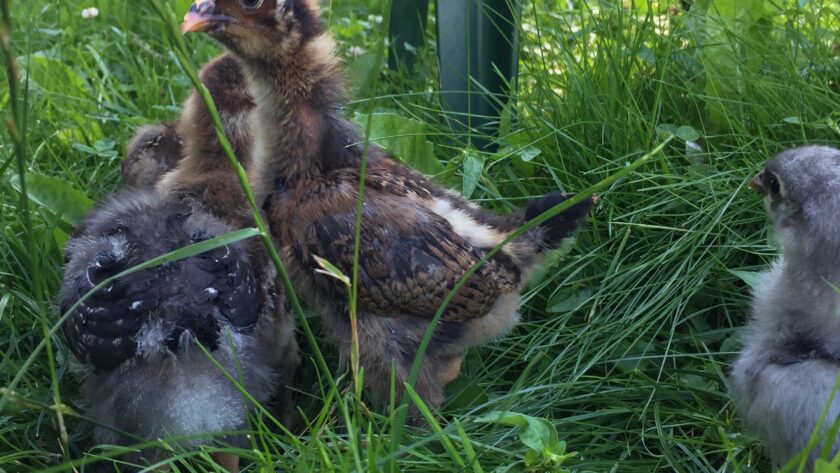


Reblogged this on Blue Dragon Journal.
Reblogged this on Paths I Walk.
Reblogged this on Rattiesforeverworldpresscom and commented:
Wonderful article <3
Reblogged this on dreamweaver333.
Thank you for this post… And in fact alll of them. I am wondering where you are located as it looks very lush and forested. I imagine ones physical surroundings makes a difference as to what you can raise and how many? I am in Santa Fe, NM, not a place for raising a lot of birds. But I’m thinking of moving to a wetter, rural location.
Thanks! Michelle
Hi Michelle! I’m in Western PA, in the Allegheny Mountains, so a temperate climate. Winter is the hardest for them. I know that people do raise birds in desert climates, but they have different needs.
What great info! I was just talking with the hubby about how many eggs are possible a year with different types of birds. You answered that one!
I wish I could have some, but travel too much.
Chickens can be given an automatic door and they will go in and out and you can give them food that lasts several days. The other birds would need more care and make it harder to go away!
Hi Dana,
Nice article but I am shocked, shocked to my, core that you didn’t mention the Buff Orpington breed of chickens. With their deep, golden plumage and imposing size, they are among the most gorgeous of heritage chicken breeds and being English, they have fantastically eccentric personalities. We have kept them for years and they are a good breed for cold winter areas. The roosters are great talkers and dancers.
Everyone in the country is passionate about their favorite breed of chicken.
Maxine
Hi Max, Nice to hear from you!
Nice to hear from you!
I’m more of a fan of Wyondottes than Buff Orpingtons! Each chicken owner has her favorites, I guess, haha! I haven’t raised too many Orpingtons, however, so maybe I need more experience with them. Right now I am in love with my Cochins, both my hens and delightful rooster!